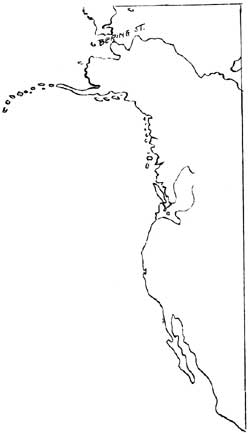
 | ||||||||

The history of any region begins, not merely with events upon the threshold of its development but more properly in the years that preceeded the crossing of this figurative portal. Thus episodes that have apparently, little bearing upon a region's future must first be considered. It is in them that we find the nucleii of what will later come to pass; in them we find the motive power or the happenstance that has shaped the course of destiny. Thus in the case of the history of this region let us first consider the goal of early exploration in the New World. From the time that Balboa (1503) discovered that a great ocean lay between the new lands and the object of the original quest of Columbus - from that time early mariners began their search for the mythical "Straits of Anian," an easy route through the new lands to the fabulously rich Indies. Upon that hinged the early explorations and conquests for the North Pacific. At first, however, little effort was expended in penetrating into the north. Spain, then firmly entrenched in America, found the rich lands of Mexico, Peru and other closely related regions offering too much in the promise of immediate reward to be bothered with journeys of doubtful return. Such conquests could await her leisure. The advent of Francis Drake, that bold adventuresome Englishman, into the Pacific arena in 1597 might have spurred Spain to greater endeavor in this regard had not this thrust into what was heretofore Spanish domain been reduced in importance by the advent of a war between England and Spain, the stage of which was set nearer home on the bosom of the Atlantic. But in spite of European wars and the rich lands that bordered the Caribbean and the Central Pacific there never was lost sight of the possibility of a short, safe and easy water route through the Americas to the Indies. The discovery of such a route served as a beacon of hope for many mariners and because of this falsification of such discovery was frequent. Many of these supposed discoveries were substantiated by maps, charts, diagrams and descriptions, but unscrupulous men had made these efforts to gain renown it was sooner or later proven. Yet there is one episode of this kind that, while never actually determined as fact, has not yet been proven definitely false. More- it accounts for the name of the Straits of Juan de Fuca by which the placid waters of Puget Sound are joined with those of the great Pacific. In 1596 an Englishman named Michael Lok met a Greek mariner, known as Juan de Fuca in Venice. Juan de Fuca's real name was Apostolos Valerianos and he claimed to have sailed north along the Pacific Coast in the service of Spain in 1592 with the express purpose of discovering and fortifying the "Straits of Anian." Between 47 and 48 degrees - so said de Fuca - his ship entered a broad inlet that extended in general in an easterly direction. In this inlet he claimed to have sailed for twenty days, passing many islands. Returning to Mexico from this journey he became disgruntled at the treatment given him by the Spanish authorities there, and in consequence, left the service of Spain. Investigations in later years brought out the fact that no Spanish explorations of that kind had any record and that no man by the name of Juan de Fuca or Apostolos Valerianos had ever existed. Perhaps this tale, like many others of its kind, was a hoax. Yet the description given Lok was fairly accurate in detail and those innaccuracies might be credited to the manner in which the story was transmitted to Lok, who, being unfamiliar with the northwest, could easily have been guilty of mistating Fuca's words or misunderstanding his language. So, if Fuca's tale was true, he was the first white man to see the waters of Puget Sound. The name - Strait of Juan de Fuca - was conferred to this waterway in 1787 by Capt. John Meares. (C.F.B.) . . . . . . . . . . NOTE: This is the first of a series of short articles taken from the history section of the Mt. Rainier National Park Encyclopedia that will be included in future issues of "Nature Notes." These articles will outline the history of Mt. Rainier National Park, and the Pacific Northwest as it applies to "the Mountain," to the present day. (C.F.B.) | ||||||
| <<< Previous | > Cover < | Next >>> |
vol11-10c.htm
17-Nov-2001